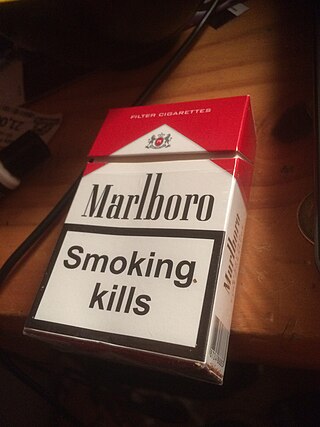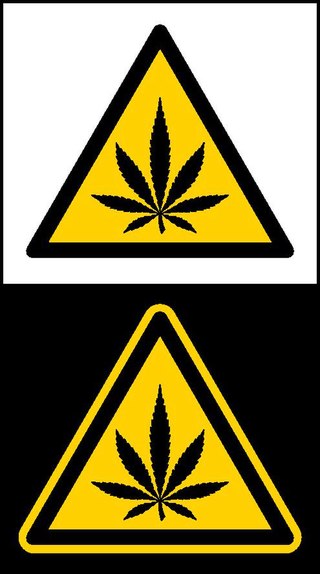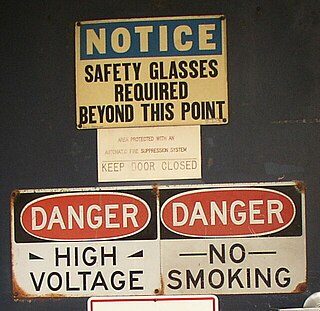
A biological hazard, or biohazard, is a biological substance that poses a threat to the health of living organisms, primarily humans. This could include a sample of a microorganism, virus or toxin that can adversely affect human health. A biohazard could also be a substance harmful to other living beings.

A steel-toe boot is a durable boot or shoe that has a protective reinforcement in the toe which protects the foot from falling objects or compression. Safety shoes are effective in keeping the feet of industrial workers safe from sharp and heavy objects while working in factories.

The general prohibition sign, also known informally as the no symbol, 'do not' sign, circle-backslash symbol, nay, interdictory circle, prohibited symbol, don't do it symbol, or universal no, is a red circle with a 45-degree diagonal line inside the circle from upper-left to lower-right. It is typically overlaid on a pictogram to warn that an activity is not permitted, or has accompanying text to describe what is prohibited.

Hazard symbols or warning symbols are recognisable symbols designed to warn about hazardous or dangerous materials, locations, or objects, including electromagnetic fields, electric currents; harsh, toxic or unstable chemicals ; and radioactivity. The use of hazard symbols is often regulated by law and directed by standards organizations. Hazard symbols may appear with different colors, backgrounds, borders, and supplemental information in order to specify the type of hazard and the level of threat. Warning symbols are used in many places in place of or in addition to written warnings as they are quickly recognized and more universally understood, as the same symbol can be recognized as having the same meaning to speakers of different languages.

A warning label is a label attached to a product, or contained in a product's instruction manual, warning the user about risks associated with its use, and may include restrictions by the manufacturer or seller on certain uses. Most of them are placed to limit civil liability in lawsuits against the item's manufacturer or seller. That sometimes results in labels which for some people seem to state the obvious.

On computer keyboards, the enter key⌅ Enter and return key↵ Return are two closely related keys with overlapping and distinct functions dependent on operating system and application.

ISO 7001 is a standard published by the International Organization for Standardization that defines a set of pictograms and symbols for public information. The latest version, ISO 7001:2023, was published in February 2023.
A placard is a notice installed in a public place, like a small card, sign, or plaque. It can be attached to or hung from a vehicle or building to indicate information about the vehicle operator or contents of a vehicle or building. It can also refer to paperboard signs or notice carried by picketers or demonstrators.

The Globally Harmonized System of Classification and Labelling of Chemicals (GHS) is an internationally agreed-upon standard managed by the United Nations that was set up to replace the assortment of hazardous material classification and labelling schemes previously used around the world. Core elements of the GHS include standardized hazard testing criteria, universal warning pictograms, and safety data sheets which provide users of dangerous goods relevant information with consistent organization. The system acts as a complement to the UN numbered system of regulated hazardous material transport. Implementation is managed through the UN Secretariat. Although adoption has taken time, as of 2017, the system has been enacted to significant extents in most major countries of the world. This includes the European Union, which has implemented the United Nations' GHS into EU law as the CLP Regulation, and United States Occupational Safety and Health Administration standards.
In United States safety standards, precautionary statements are sentences providing information on potential hazards and proper procedures. They are used in situations from consumer product on labels and manuals to descriptions of physical activities. Various methods are used to bring focus to them, such as setting apart from normal text, graphic icons, changes in text's font and color. Texts will often clarify the types of statements and their meanings within the text. Common precautionary statements are described below.
ANSI Z535 is an American standard that sets forth a system for presenting safety and accident prevention information. It corresponds to the international ISO 3864 standard and can be integrated with other ISO standards to meet global HazCom standards when products and related documentation must be properly labeled for export.
The German keyboard layout is a QWERTZ keyboard layout commonly used in Austria and Germany. It is based on one defined in a former edition of the German standard DIN 2137–2. The current edition DIN 2137-1:2012-06 standardizes it as the first (basic) one of three layouts, calling it "T1".

In the process industry, chemical industry, manufacturing industry, and other commercial and industrial contexts, pipe marking is used to identify the contents, properties and flow direction of fluids in piping. It is typically carried out by marking piping through labels and color codes. Pipe marking helps personnel and fire response teams identify the correct pipes for operational, maintenance or emergency response purposes.

Mr. Ouch is a hazard symbol developed by the US’s National Electrical Manufacturers Association (NEMA) to represent electrical hazard within pad-mounted transformers. Unlike other high-voltage warning symbols, Mr. Ouch was specifically designed with young children in mind. It is part of NEMA Standard 260-1996, Safety Labels for Pad-Mounted Switchgear and Transformers Sited in Public Areas, which lays out design guidelines for a complete label design that incorporates the Mr. Ouch symbol.
ISO 7010 is an International Organization for Standardization technical standard for graphical hazard symbols on hazard and safety signs, including those indicating emergency exits. It uses colours and principles set out in ISO 3864 for these symbols, and is intended to provide "safety information that relies as little as possible on the use of words to achieve understanding."

Safety signs are a type of sign designed to warn of hazards, indicate mandatory actions or required use of Personal protective equipment, prohibit actions or objects, identify the location of firefighting or safety equipment, or marking of exit routes.

ASTM D8441 is an ASTM International standard defining the International Intoxicating Cannabinoid Product Symbol (IICPS). As of mid-2022, the symbol has been incorporated into the universal symbols required for cannabis packages in the states of Montana, New Jersey, South Dakota and Vermont.

ANSI Z35.1 the Specifications for Accident Prevention Signs, was an American standard that dictated the layout, colors and wording of safety signs in the United States. The standard is the first American standard that made specific demands for the design, construction, and placement of safety signage in industrial environments. The first edition was published in January 1941, and the fourth and final edition in November 1972. Changes in societal needs of signage, and further research into signage would result in the establishment of a new committee, the ANSI Z535 Committee on Safety Signs and Colors, combining the separate committees of Z35.1 - Specifications for Accident Prevention Signs, Z35.2 - Specifications for Accident Prevention Tags, and Z53 - Marking Physical Hazards Safety Color Code, resulting in a new combined standard, ANSI Z535.

The Directive 92/58/EEC specifies the minimum requirements for safety signs within the European Union. It superseded the Directive 77/576/EEC. While not being replaced by the standard ISO 7010, both signage systems can be used. This directive does not apply to signage used for controlling roadway, railway, waterway or air transportation.

The Health and Safety Regulations 1996 specify the safety signs within Great Britain, Northern Ireland has a similar law. It was issued as a transposition of the European directive 92/58/EEC and replaced The Safety Signs Regulations 1980. They consist of "traditional safety signs", such as prohibitory and warning signs, hand signals, spoken and acoustic signals and hazard marking.


























